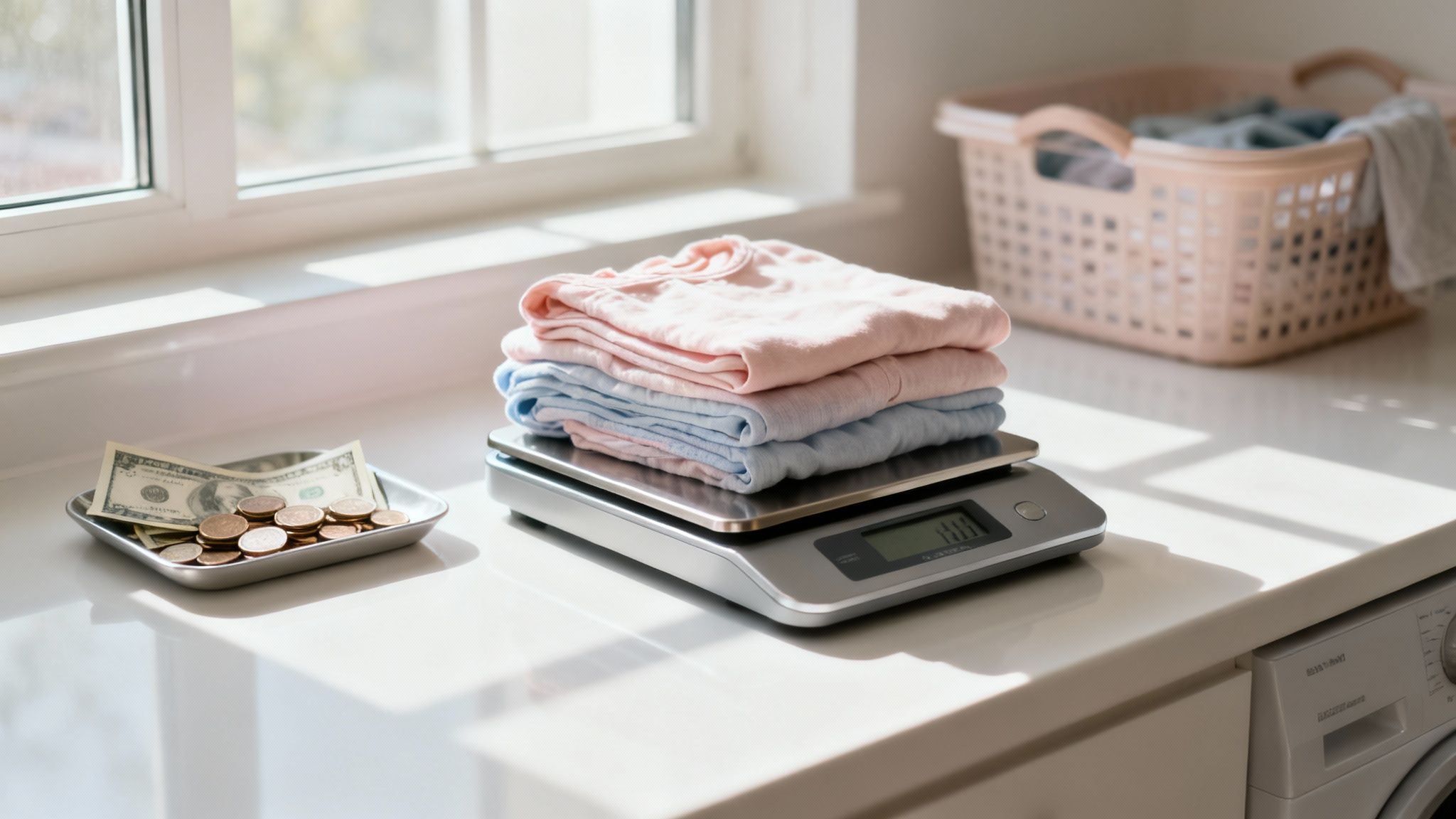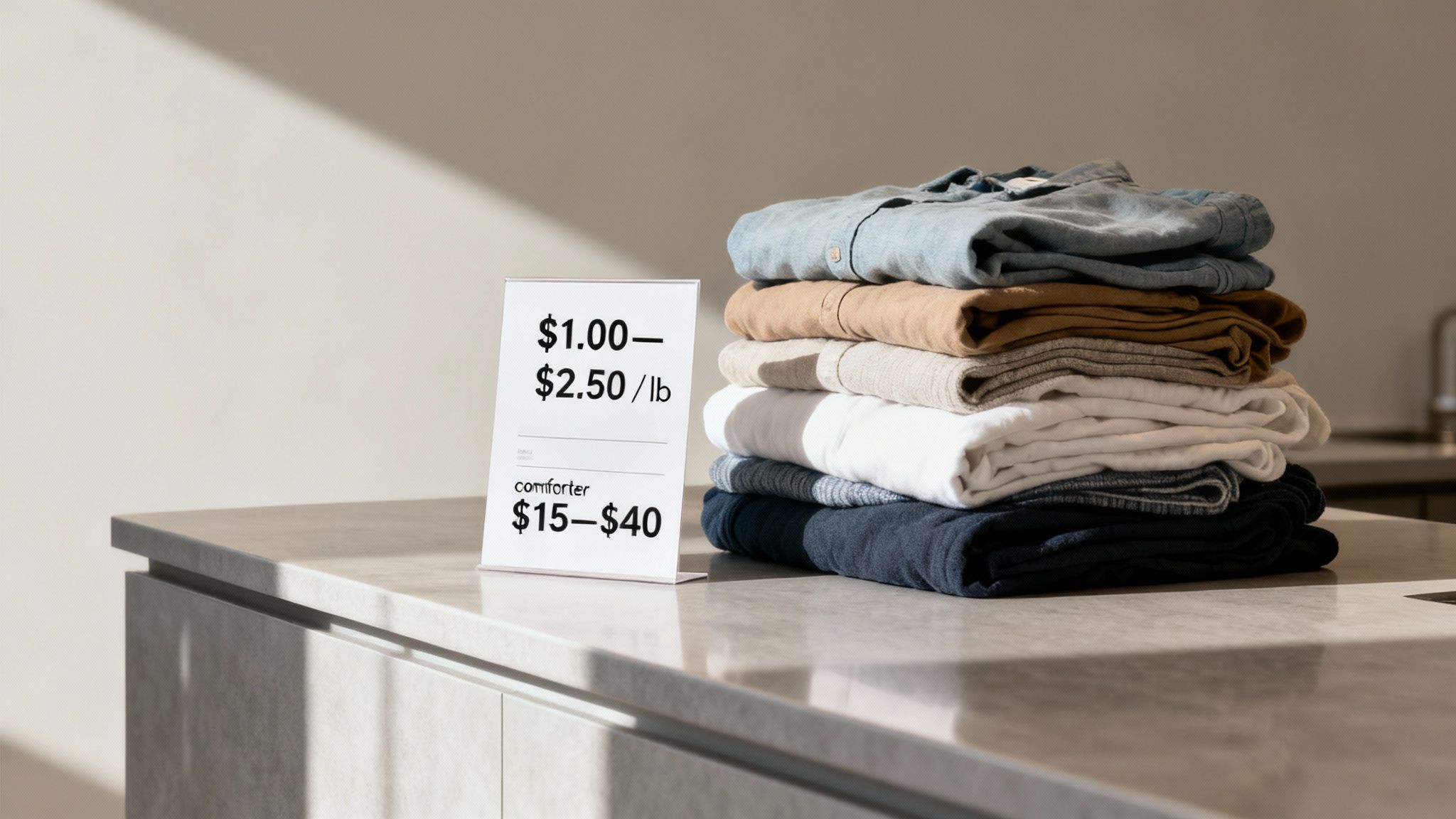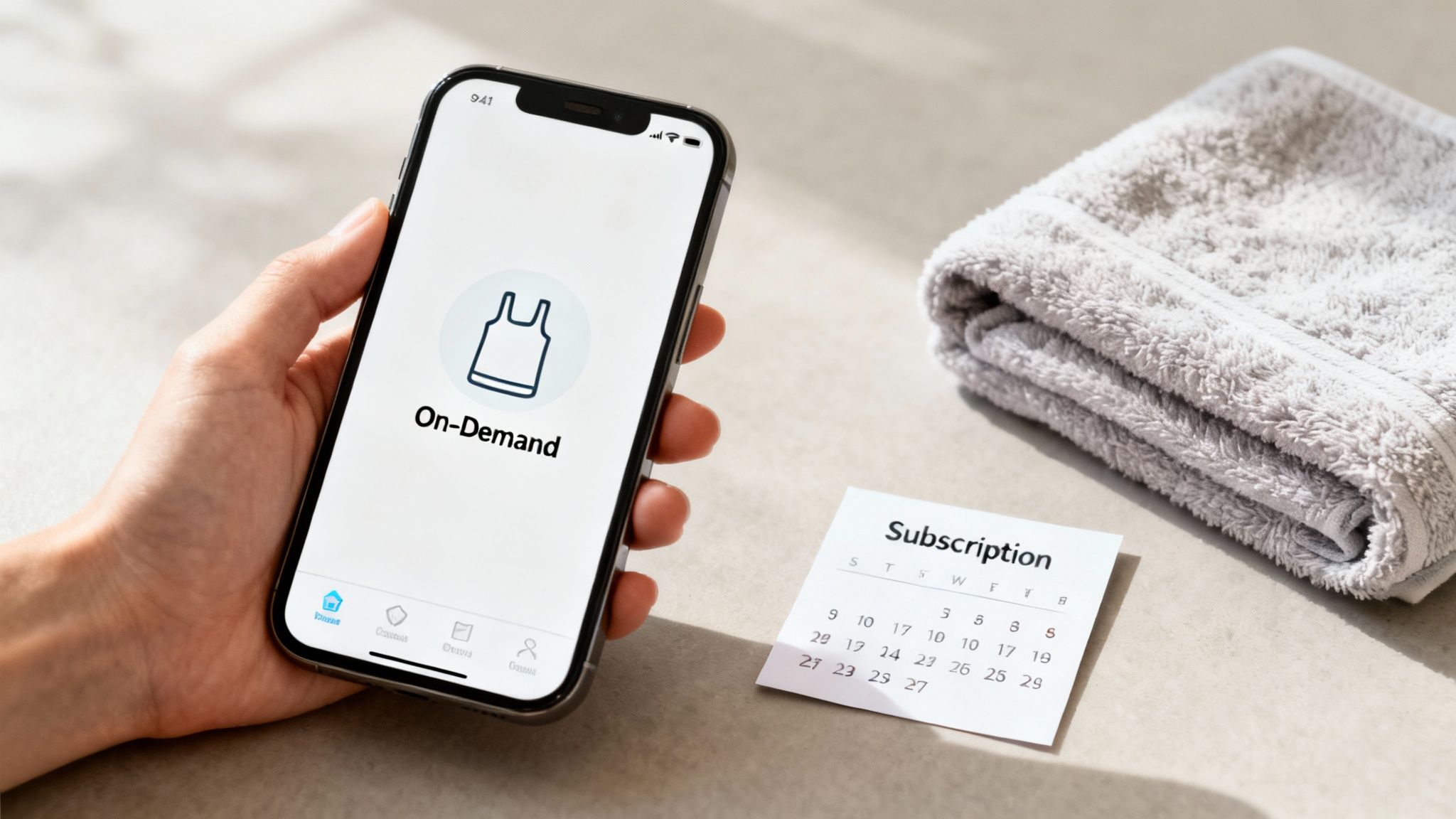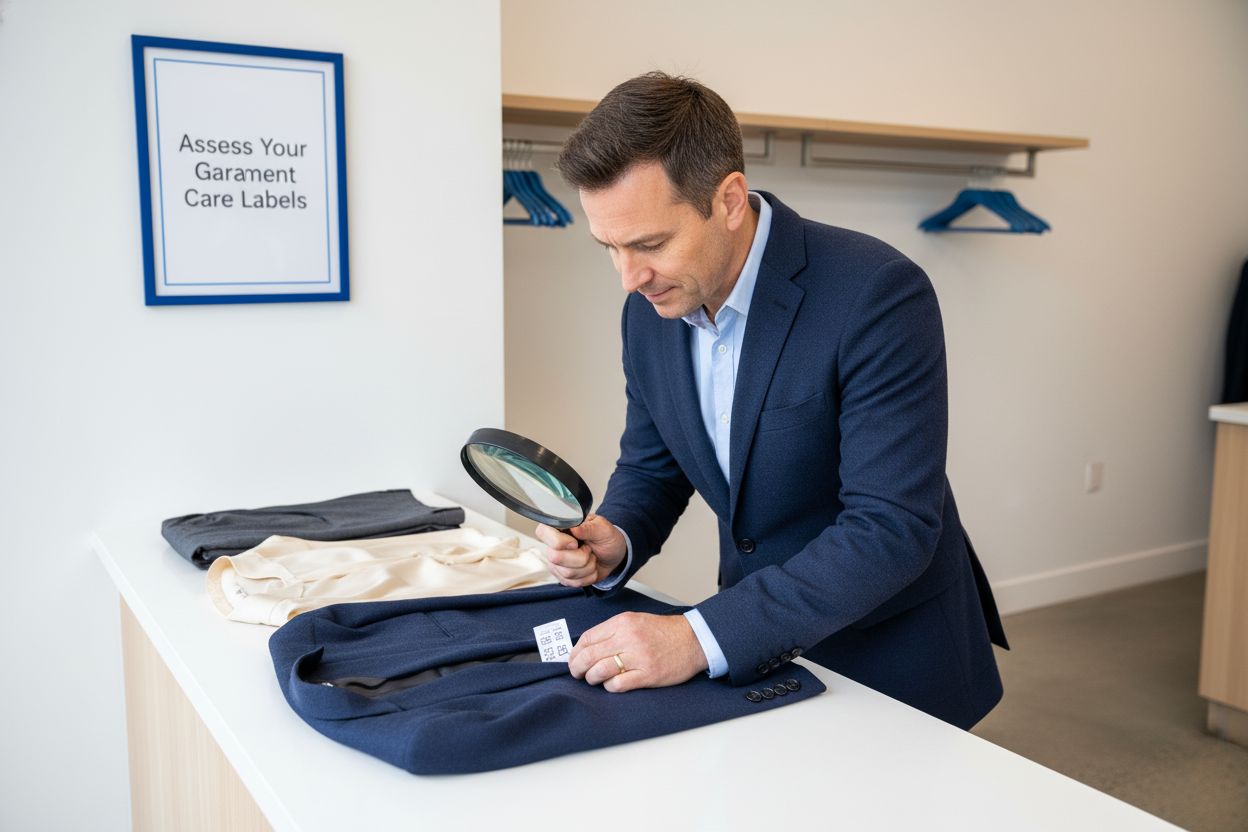How Much Does Laundry Service Cost A Price Guide

Let's be honest, staring at a mountain of laundry is no one's idea of a fun weekend. If you're thinking about outsourcing the chore, the first question on your mind is probably: "How much is this going to cost me?"
On average, you can expect a standard wash-and-fold service to run you somewhere between $1.50 to $3.50 per pound. The final tally depends on where you live, what you're getting cleaned, and how fast you need it back. Bigger, bulkier things like comforters are usually priced per piece, typically in the $25 to $35 range.
What Is the Average Cost of Laundry Service?
Tired of dedicating your weekends to the spin cycle? Understanding the average cost of laundry service is the first step to getting your time back. The price isn't one single number—it’s a range that moves based on a few key factors. But we can definitely pin down a solid baseline to help you figure out a budget.
For your everyday clothes—think t-shirts, jeans, towels, and socks—the most common way laundromats charge is by weight. This is where that $1.50 to $3.50 per pound range comes from. It's a lot like buying apples at the grocery store; the more it weighs, the more it costs.
Most places have a minimum order size, usually around 15-20 pounds. To give you a visual, that’s about what you can stuff into a standard kitchen trash bag. For a more detailed look at how these costs break down, you can dive into our complete laundry service pricing guide.
Average Laundry Service Costs at a Glance
Of course, not everything fits neatly into a bag to be weighed. Bulky items or clothes that need special attention are priced a bit differently. To make it simple, here’s a quick table summarizing what you can generally expect to pay for common services.
This table gives you a handy reference point, but remember that prices can vary based on your specific needs and location.
The Growing Demand for Convenience
The appeal of laundry services is blowing up, and it points to a big shift in how we think about our time. The global market for these services was valued at a staggering USD 78.20 billion and is expected to climb to USD 118.71 billion by 2030.
This isn't just some random statistic. It shows a clear trend: people are choosing convenience and time-saving solutions more than ever. What used to be a luxury is quickly becoming a practical necessity for busy people everywhere. You can learn more about this growing market on Grand View Research.

While these averages give you a great starting point, keep in mind that other things can affect your final bill. Need it back the same day? That might add a surcharge. Prefer a premium, hypoallergenic detergent? That could adjust the total, too. Next, we’ll get into all those little variables so you can get a crystal-clear picture of what your laundry service will cost.
Understanding Per Pound Vs. Per Item Pricing

When you first look at a laundry service's price list, you'll see two main ways they charge: by the pound and by the item. Getting a handle on the difference is the secret to guessing your final bill and making sure there are no surprises when it's time to pay.
These two pricing models don't compete with each other. Instead, they work together to make sure every piece of clothing gets the right kind of care for a fair price.
Think of per-pound pricing like a trip to the bulk bins at the grocery store. You fill up a bag, they weigh it, and you pay based on that weight. Laundry services do the exact same thing with your durable, everyday clothes that can all be washed and dried together.
It's a simple, efficient way to handle the bulk of your laundry basket, making life easier for both you and the launderer.
What Goes in the Per-Pound Bag
So, what exactly gets tossed in the "by the pound" pile? The general rule is anything that can handle a standard wash and dry cycle without needing special attention.
- T-shirts and Casual Shirts: All your go-to cotton and poly-blend tops.
- Jeans and Shorts: Hardy denim and other tough fabrics that are made to last.
- Socks and Underwear: Small, simple items that are perfect for washing in bulk.
- Towels and Washcloths: Everyday terry cloth bath linens.
- Basic Bedding: Your standard cotton or flannel sheets and pillowcases.
By bundling these common items together and charging by weight, services can offer a cost-effective solution for your weekly laundry needs. This is the foundation of the standard wash-and-fold service.
The entire laundry and dry-cleaning market is a mixed bag of these pricing structures. In the U.S. alone, it's a USD 9.80 billion industry filled with countless providers doing everything from basic laundry to specialized duvet cleaning. This is why you see different prices for different garments—everyone is carving out their own niche.
When Per-Item Pricing Makes Sense
Now for the items that can't just be tossed in a bag and weighed. Per-item pricing is for clothing that needs individual attention, specific cleaning methods, or just a more delicate touch.
Think of this less like buying in bulk and more like commissioning a custom piece of furniture—the price depends on the material, the complexity of the job, and the skill needed to do it right. This model is crucial for protecting your more valuable clothes and making sure they last. These items often require dry cleaning, special stain treatments, or careful pressing that just isn't part of a standard wash-and-fold process.
If you want to dive deeper, our per-pound laundry pricing guide gives you a complete breakdown. The cost is higher for these items because it reflects the specialized labor, time, and materials involved. A professional is essentially treating each garment as its own unique project.
Common Per-Item Garments
You can expect to pay by the piece for anything with a "dry clean only" tag or items that are too big for a regular machine.
- Suits and Blazers: These structured pieces need dry cleaning to hold their shape.
- Silk Blouses and Dresses: Delicate fabrics like silk or satin would be ruined in a traditional washer.
- Winter Coats: Heavy wool or down-filled coats need special handling to get them clean without causing damage.
- Bulky Bedding: Large comforters and duvets are priced individually because they take up an entire machine by themselves.
- Formal Gowns: Intricate dresses with beading, lace, or special construction require an expert's touch.
A typical order often has both. You might have a large bag of clothes charged by the pound, plus a suit and a comforter that are charged individually. This hybrid approach means you only pay for specialized care when you actually need it, keeping professional laundry service both effective and affordable.
Key Factors That Influence Your Final Bill
That per-pound or per-item price you see on a laundry service’s website? Think of it as the starting line, not the finish. It’s a lot like the base price of a car; a few choices and conditions can change the final number. Getting a handle on these variables is the key to mastering your laundry budget and making sure there are no surprises when the bill comes.
From your zip code to how fast you need your clothes back, a handful of key factors really shape the final cost. Once you know what they are, you can tailor your order to fit your exact needs—and your wallet.
Your Geographic Location Matters
One of the biggest drivers of your laundry bill is, believe it or not, your address. Just like a cup of coffee costs more in a big city than in a small town, so does getting your laundry done. In dense urban areas, things like rent, labor, and utilities are way more expensive, and those costs naturally get baked into the prices you pay.
For example, you can expect to pay a premium in major metro areas like New York City or San Francisco, where wash-and-fold rates might climb to $2.00 to $3.50 per pound. Head out to the suburbs or a more rural spot, and you’ll find lower overhead costs allow for more competitive pricing, sometimes dropping as low as $1.00 to $1.50 per pound. This kind of regional price difference is pretty standard across most service industries.
Turnaround Time Surcharges
Patience is a virtue, but let’s be real—sometimes you just need that favorite shirt back now. Most laundry services offer a standard 48-hour turnaround, which is your most budget-friendly option. But if you’re in a pinch, you can almost always pay a little extra for speed.
- Standard Service (48 Hours): This is the baseline price with no extra fees. It’s your best bet for routine laundry.
- Next-Day Service (24 Hours): Need it back by tomorrow? Expect to pay a premium, often an extra 30% to 40% on top of your total bill.
- Same-Day or Express Service: For the absolute fastest turnaround, some services will add a flat rush fee, which could be anywhere from $10 to $15 extra per order.
A little planning goes a long way here. If you can build that standard two-day window into your routine, you’ll sidestep those convenience fees completely.
The Takeaway: The final cost of your laundry service is a blend of the base rate and the choices you make. Opting for speed, special detergents, or extra care will nudge the price up, while sticking to the standard options keeps things simple and predictable.
Special Requests and Add-Ons
Your laundry isn't one-size-fits-all, and most services get that. They usually offer a menu of options so you can customize your order. These add-ons give your clothes a little extra TLC, but they will also add to your final bill.
Some of the most common extras include:
- Premium or Hypoallergenic Detergents: A solid, standard detergent is usually included, but you can often upgrade to a specific brand like Tide or pick a gentle, hypoallergenic option for a small upcharge.
- Stain Treatment: Got a stubborn wine or oil stain? Specialized spot treatment takes extra time and specific products, which might come with a separate fee.
- Special Handling: If you want certain items hung up instead of folded, or air-dried instead of machine-tumbled, that can also add a small per-item cost.
Pickup and Delivery Fees
The magic of having your laundry whisked away from your doorstep and returned fresh and folded is a huge part of the appeal. Some services roll this cost into their per-pound price, but others charge a separate delivery fee. This fee might be a flat rate, or it could be waived if your order is over a certain amount, often around $35 to $50.
Beyond the basics, keep an eye out for perks like loyalty programs offering fixed discounts that can make a real difference to your final bill over time. Always take a minute to check the full pricing structure to see how delivery is handled. When you understand all these moving parts, you can intelligently manage how much your laundry service costs and make it work perfectly for your life.
Comparing On-Demand and Subscription Laundry Services

The days of being stuck on a laundromat’s schedule are over. Modern laundry services have gone digital, with app-based models that put you in charge. This shift has brought two main options to the forefront: on-demand services and subscription plans. Knowing the difference is the key to figuring out how much you'll spend and which one actually fits your lifestyle.
Think of an on-demand, or pay-as-you-go, service like calling an Uber. You use it exactly when you need it and pay for that one ride. It’s perfect for those one-off situations, like coming home from a long vacation with a suitcase full of clothes or when your washing machine gives up on you. You get all the convenience of pickup and delivery with zero long-term commitment.
Subscription services, on the other hand, are more like having a monthly metro pass. You pay a set fee for a certain amount of laundry, which almost always works out to a lower cost per pound. This model is built for anyone with a consistent routine—it’s a total game-changer for busy families or professionals who know they'll have a mountain of laundry every single week.
The On-Demand Model: Flexibility at a Premium
The biggest draw of on-demand service is its incredible flexibility. No contracts, no recurring fees—you just schedule a pickup whenever you need one. This freedom is perfect for people with unpredictable laundry needs or for anyone who just wants to test out a service before going all-in.
Of course, that flexibility often comes with a slightly higher price per pound. Since the service can't count on your business every week, they price each order as it comes. You can expect to pay anywhere from $1.75 to $3.50 per pound, and you might see a delivery fee depending on your location and how quickly you need it back. It’s all about paying for convenience precisely when you need it.
The Subscription Model: Value Through Consistency
If you’re doing laundry every week or two like clockwork, a subscription plan can save you some serious cash. These plans are designed to reward loyal customers who have a predictable amount of laundry.
A subscription transforms laundry from a reactive chore into a streamlined, automated part of your routine. You set the schedule, and the service handles the rest, often at a discounted rate that makes budgeting easier.
For example, a service might offer a plan that covers 80 pounds of laundry per month for a flat fee. This could drop your per-pound cost down to $1.50 or even less, which is a huge win for families who can easily fill up multiple bags every month.
It’s no surprise the global on-demand laundry market is booming. It's projected to jump from around USD 32,954.3 million to over USD 121,246.1 million by 2035. This massive growth is all thanks to people choosing convenient, app-based solutions that give them their time back. You can dive deeper into this trend over at Future Market Insights.
Which Model Is Right for You?
Deciding between on-demand and a subscription really just comes down to your laundry habits and what you value more—flexibility or savings.
- Choose On-Demand If: Your laundry piles up randomly, you only need an extra hand once in a while, or you want to try a service without any strings attached.
- Choose Subscription If: You have a steady, predictable amount of laundry each month, you're looking for the lowest possible cost per pound, and you love the idea of "set it and forget it" convenience.
Either way, both models are a massive upgrade from spending hours at the laundromat. By taking a quick look at your needs, you can pick the service that fits your budget and gives you back your most valuable asset: your time.
Is Laundry Service Cheaper Than Doing It Yourself?

Does outsourcing your laundry actually save you money, or is it just a convenient luxury? When you first look at the per-pound price of a service, it's easy to think doing it yourself is the cheaper route. But that's only part of the story.
To get a real sense of the cost, you have to look past the price of a bottle of detergent and uncover the hidden expenses of DIY laundry. We're talking about utilities, the slow wear and tear on your expensive machines, and the one thing you can never get back—your time. It’s only when you add it all up that the true cost of your weekly laundry marathon becomes clear.
Breaking Down the Hidden Costs of DIY Laundry
Doing your own laundry comes with a surprising number of expenses that are easy to overlook. They don't appear as a single "laundry" line item on your bank statement, but trust me, they add up.
- Appliance Costs: A new washer and dryer set can easily run you $800 to $2,500. If those machines last about 10 years, you're looking at a hidden cost of $80 to $250 per year before you've even washed a single sock.
- Utilities: Every single load uses water and electricity. A standard washer uses about $0.42 in utilities per load, while a dryer adds another $0.61. It might not sound like a lot, but for a family doing four loads a week, that’s over $200 a year just in energy costs. Finding ways to reduce appliance running costs can help, but you can't eliminate this expense entirely.
- Supplies: This is the obvious one—detergent, fabric softener, and stain removers. Depending on the brands you prefer, this can add another $0.20 to $0.60 per load.
The Most Valuable Asset: Your Time
But the biggest hidden cost isn't about money at all. It's about your time.
The average household spends a staggering five to eight hours per week on laundry. That’s everything from sorting and washing to drying, folding, and finally putting it all away.
Think about it this way: if you value your time at a modest $20 an hour, you’re spending $100 to $160 worth of your time every single week just on laundry. All of a sudden, paying a professional to handle it all seems like a pretty smart trade.
This reclaimed time is where a professional laundry service really shines. It's hours you get back to spend with your family, work on a hobby, or just relax instead of being chained to the laundry room.
A Side-by-Side Cost Comparison
So, let's put it all into perspective. Below is a table breaking down the estimated monthly costs for a family doing about 80 pounds of laundry.
DIY Laundry vs Professional Service Monthly Cost Breakdown
While the direct cash you spend on a professional service is higher, the value-based calculation tells a completely different story. Once you factor in your time and the hidden costs of owning and running your own machines, using a laundry service can be a surprisingly savvy decision. You're not just buying clean clothes; you're buying back your most limited resource—your weekend.
How We Price Our Services at Columbia Pike Laundry
Knowing the industry average for laundry service is one thing, but seeing how it works in the real world makes all the difference. At Columbia Pike Laundry, we’re big believers in keeping things simple and honest. No hidden fees, no confusing upcharges—just straightforward pricing so you always know exactly what you're paying for.
Our whole goal is to take the guesswork out of laundry day. We’ve set up our pricing to be predictable, fair, and focused on giving you back your most valuable resource: your time. By combining per-pound rates for everyday laundry with per-item pricing for special garments, we make sure you only pay for the specific care your clothes need.
Our Wash and Fold Pricing
For all your everyday clothes—the t-shirts, jeans, socks, and towels—our wash-and-fold service is the heart of what we do. We charge a competitive rate per pound, which covers everything: sorting, washing with our default Free & Clear detergent, drying, and folding everything perfectly. It’s the easiest way to handle the bulk of your laundry basket.
To make sure we can give every order the attention it deserves, we do have a minimum order size.
- In-Store Drop-Off Minimum: $38 per order
- Pickup & Delivery Minimum: $50 per order
To give you a better idea, these minimums usually cover around 15 pounds of laundry, which is about what you can fit into a standard kitchen-sized trash bag.
Pricing for Bulky Items and Dry Cleaning
Of course, not everything fits neatly into a "per-pound" category. Some items are too big or too delicate for a standard wash. That's why we price things like comforters, sleeping bags, and dry-clean-only garments individually. This ensures they get the dedicated machine space or specialized cleaning they require.
Here at Columbia Pike Laundry, we treat your clothes like they're our own. Separating bulky and delicate items isn't just about process—it's about protecting your favorite garments and making sure everything comes back perfectly clean.
A comforter is a great example. We charge $25 for a standard machine wash and fold. But if the care tag says it needs to be dry-cleaned, the price is adjusted to reflect that more intricate process. You can see a complete breakdown of our costs for both bulky items and dry cleaning by checking out our full pricing details on our website.
Turnaround Times and Getting Started
We get it—you need your clothes back, and you need them back fast. Our standard turnaround for wash-and-fold is just 48 hours, which gives us enough time to get everything spotlessly clean and perfectly folded. For dry cleaning, our standard turnaround is 3 days.
Ready to cross laundry off your to-do list for good? Scheduling your first pickup is easy. Just head over to our booking page, pick a time that works for you, and we’ll take it from there. Get ready to experience the pure relief of having your laundry professionally done and delivered right to your door.
A Few Final Questions About Laundry Service Costs
Even after you get the hang of the pricing models, a few practical questions usually pop up before you're ready to schedule that first pickup. Getting these last details ironed out helps you know exactly what to expect, making the whole thing smooth and simple from the get-go.
Let's walk through some of the most common questions we hear about the cost and logistics of using a laundry service.
Is It Cheaper to Use a Laundry Service or a Laundromat?
On the surface, a laundromat seems like the more wallet-friendly choice. You’re typically looking at $4 to $8 to wash and dry a single load. But that price tag completely ignores your most valuable resource: your time.
When you weigh that against a wash-and-fold service charging $1.50 to $2.50 per pound, the math starts to change. Think about it—you're easily saving 2-3 hours you'd otherwise spend hauling, waiting, and folding at the laundromat. For busy professionals or parents juggling a million things, the convenience and time you get back often make a professional service the far better deal.
How Much Laundry Actually Fits in a Standard Pickup Bag?
Most laundry services will give you a standard-sized bag that’s designed to hold about two to three loads of laundry. In terms of weight, that usually comes out to between 20 and 30 pounds.
A helpful visual: Picture a standard 13-gallon kitchen trash bag filled with clothes. That's roughly what we're talking about. It's usually plenty for one person's weekly laundry or what a couple might go through in several days.
Do I Need to Tip the Laundry Delivery Driver?
Tipping is never a requirement, but just like with a food delivery driver, it's always a welcome way to show appreciation for great service. Your driver is the one making sure your laundry is handled with care, from pickup to a safe return.
A good rule of thumb is to tip 10-20% of your total order cost. Most modern laundry apps and websites make it super easy, with a tipping option built right into the payment screen after your fresh, folded clothes are back on your doorstep.
Ready to stop wondering and start enjoying the convenience for yourself? Columbia Pike Laundry is here to take that chore completely off your plate.
Popular Blog Articles

Meet the Author
Daniel Logan didn’t start CPL because he loved laundry. He started it because his family was drowning in time debt, and laundry was one of the biggest weights.
Mornings were chaos with two kids under 5. Evenings felt like catch-up. And weekends? Gone to sorting socks and folding piles.
He knew his story wasn’t unique. So he built a business that gave families like his just a little bit of breathing room one load at a time.
With no laundry experience but deep tech skills, Daniel rolled up his sleeves, doing every job himself while building systems that turned it into a modern laundry service that saves customers time, simplifies their lives, and delivers reliability they can count on.
That’s where CPL began. Not from a playbook, but from pain. From one dad trying to buy back time: for himself, and for every household like his.





